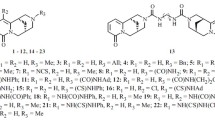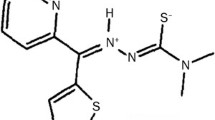Summary
S16020-2 is a new olivacine derivative which has recently shown a marked antitumor activity in various experimental models. This study was undertaken in order to measure the inhibition of the proliferation of various sensitive and resistant tumor cell lines, by S16020-2, and to obtain information concerning its mechanism of action.
For a continuous exposure, S16020-2 was as cytotoxic as adriamycin (ADR) (mean IC50 of about 28 nM) and on average, 46 fold more potent than elliptinium acetate (ELP), against a panel of 20 non-multidrug resistant cell lines. With a short exposure (1 hour) followed by a post-incubation of 95 hours in drug-free medium, S16020-2 was 5 and 6 fold more cytotoxic than ADR for human lung A549 and murine melanoma B16 cells, respectively. Furthermore, S16020-2 inhibited more actively the formation of colonies issued from proliferating cells, compared to colonies issued from quiescent A549 cells. Because quiescent cells demonstrated a 3 fold lower level of topoisomerase IIα (topo II) than proliferating cells, these results suggest that this enzyme could be a potential target for S16020-2. In addition, as demonstrated by flow cytometric studies, S16020-2 intercalated into DNA and induced a cell cycle arrest in G2.
Cell lines displaying the multidrug resistance (MDR) phenotype, P388/ADR-1, P388/ADR, P388/VCR-20, KB-A1, DC-3F/AD, S1/tMDR, and Colo320DM, were more sensitive to S16020-2 than to ADR or ELP, as shown by the mean resistance factors, 8, 201, and 23 respectively. In addition, the two cell lines displaying the pure classical MDR phenotype, linked exclusively to the P-glycoprotein (P-gp) overexpression (P388/VCR-20 and S1/tMDR), were as sensitive to S16020-2 as their sensitive parental counterparts, although they were resistant to ADR.
S16020-2 is thus one of the most potent olivacine and ellipticine derivative yet characterized. The good cytotoxicity of S16020-2 against cells displaying a P-gp-mediated multidrug resistance, and its antitumor activity in vivo delineate an important chemotherapeutic potential for this drug.
Similar content being viewed by others
References
Jasztold-Howorko R, Landras C, Pierre A, Atassi G, Guilbaud N, Kraus-Berthier L, Leonce S, Rolland Y, Prost JF, Bisagni E: Synthesis and evaluation of 9-hydroxy-5-methyl-(5,6-dimethyl)-6H-pyrido[4,3b] carbazole-1-N([dialkylamino)alkyl] carboxamides, a new promising series of antitumor olivacine derivatives. J Med Chem 37:2445–2452, 1994
Kraus-Berthier L, Guilbaud N, Leonce S, Saint-Dizier D, Rouillon MH, Jan M, Burbridge M, Pierre A, Atassi G: Antitumor effect of S16020–2 against experimental lung carcinoma. Proc Am Assoc Cancer Res 36:386, 1995
Le Mee S, Markovits J, Pierre A, Atassi G, Bisagni E, Jacquemin-Sablon A, Saucier JM: In vitro studies of S16020-2, a new antitumour pyridocarbazole derivative. The fifth conference on DNA topoisomerases in therapy. New York, 1994
Leonce S, Pierre A, Anstett M, Perez V, Genton A, Bizzari JP, Atassi G: Effects of a new triazinoaminopi-peridine derivative on adriamycin accumulation and retention in cells displaying P-glycoprotein-mediated multidrug resistance. Biochem Pharmacol 44:1707–1715, 1992
Charcosset JY, Saucier JM, Jacquemin-Sablon A: Reduced DNA topoisomerase II activity and drug-stimulated DNA cleavage in 9-hydroxyellipticine resistant cells. Biochem Pharmacol 37:2145–2149, 1988
Danks MK, Schmidt CA, Cirtain MC, Suttle DP, Beck WT: Altered catalytic activity of and DNA topoisomerase II from human leukemic cells selected for resistance to VM-26. Biochemistry 27:8861–8869, 1988
Rouësse J, Spielmann M, Turpin F, Le Chevalier T, Azab M, Mondesir JM: Phase II study of elliptinium acetate salvage treatment of advanced breast cancer. Eur J Cancer 29A:856–859, 1993
Alley MC, Scudiero DA, Monks A, Hursey ML, Czerwinski MJ, Fine DL, Abbott BJ, Mayo JG, Shoemaker RH, Boyd MR: Feasibility of drug screening with panels of human tumor cell lines using a microculture tetrazolium assay. Cancer Res 48:589–601, 1988
Pierre A, Kraus-Berthier L, Atassi G, Cros S, Poupon MF, Lavielle G, Berlion M, Bizzari JP: Preclinical antitumor activity of a new vinca alkaloid derivative, S12363. Cancer Res 51:2312–2318, 1991
Gerdes J, Lemke H, Baisch H, Wacker HH, Schwab U, Stein H: Cell cycle analysis of a cell proliferation-associated human nuclear antigen defined by the monoclonal antibody Ki-67. J Immunol 133:1710–1715, 1984
Baisch H, Gerdes J: Simultaneous staining of exponentially growing versus plateau phase cells with the proliferation-associated antibody Ki-67 and propidium iodide: analysis by flow cytometry. Cell Tissue Kinet 20:387–391, 1987
Prosperi E, Sala E, Negri C, Oliani C, Supino R, Astraldi Ricotti GBC, Bottiroli G: Topoisomerase IIα and β in human tumor cells grown in vitro and in vivo. Anticancer Res 12:2093–2100, 1992
Negri C, Chiesa R, Cerino A, Bestano M, Sala C, Zini N, Maraldi M, Astraldi Ricotti GBC: Monoclonal antibodies to human-DNA topoisomerase I and the two isoforms of DNA topoisomerase II: 170 and 180-kDa isozymes. Exp Cell Rec 200:452–459, 1992
Le Pecq JB, Paoletti C: A fluorescent complex between ethidium bromide and nucleic acids. Physical-chemical characterization. J Mol Biol 27:87–106, 1967
Pelletier H, Millot JM, Chauffert B, Manfait M, Genne P, Martin F: Mechanisms of resistance of confluent human and rat colon cancer cells to anthracyclines: alteration of drug passive diffusion. Cancer Res 50:6626–6631, 1990
Dimanche-Boitrel MT, Pelletier H, Genne P, Petit JM, LeGrimellec C, Canal P, Ardiet C, Bastian G, Chauffert B: Confluence-dependent resistance in human colon cancer cells: role of reduced drug accumulation and low intrinsic chemosensitivity of resting cells. Int J Cancer 50:677–682, 1992
Bhuyan BK, McGovren JP, Crampton SL: Intracellular uptake of 7-con-O-methylnogarol and adriamycin by cells in culture and its relationship to cell survival. Cancer Res 41:882–887, 1981
Hsiang YH, Wu HY, Liu LF: Proliferation-dependent regulation of DNA topoisomerase II in cultured human cells. Cancer Res 48:3230–3235, 1988
Woessner RD, Mattern MR, Mirabelli CK, Johnson RK, Drake FH: Proliferation and cell cycle-dependent differences in expression of the 170 kilodalton and 180 kilodalton forms of topoisomerase II in NIH-3T3 cells. Cell growth Diff 2:209–214, 1991
Davies SM, Robson CN, Davies SL, Hickson ID: Nuclear topoisomerase II levels correlate with the sensitivity of mammalian cells to intercalating agents and epipodophyllotoxins. J Biol Chem 263:17724–17729, 1988
Zunino F, Capranico G: DNA topoisomerase II as the primary target of anti-tumor anthracyclines. Anti-Cancer Drug Design 5:307–317, 1990
Fosse P, Rene B, Charra M, Paoletti C, Saucier JM: Stimulation of topoisomerase II-mediated DNA cleavage by ellipticine derivatives: structure-activity relationship. Mol Pharmacol 42:590–595, 1992
De Isabella P, Capranico G, Binaschi M, Tinelli S, Zunino F: Evidence of DNA-topoisomerase II-dependent mechanisms of multidrug resistance in P388 leukaemia cells. Mol Pharmacol 37:11–16, 1990
Leonce S, Anstett M, Perez V, Pierre A: Flow cytometric evaluation of the cell cycle perturbations induced by S12363, a new vinca-alkaloid derivative. Anti-cancer Drugs 1:179–183, 1990
Solary E, Leteurtre F, Paul KD, Scuderio D, Hamel E, Pommier Y: Dual inhibition of topoisomerase II and tubulin polymerization by azatoxin, a novel cytotoxic agent. Biochem Pharmacol 45:2449–2456, 1993
Yoshinari T, Yamada A, Uemoura D, Nomura K, Arakawa H, Kojiri K, Yoshida E, Suda H, Okura A: Induction of topoisomerase I-mediated DNA cleavage by a new indolocarbazole, ED-110. Cancer Res 53:490–494, 1993
Author information
Authors and Affiliations
Rights and permissions
About this article
Cite this article
Léonce, S., Perez, V., Casabianca-Pignede, MR. et al. In vitro cytotoxicity of S16020-2, a new olivacine derivative. Invest New Drugs 14, 169–180 (1996). https://doi.org/10.1007/BF00210788
Issue Date:
DOI: https://doi.org/10.1007/BF00210788




